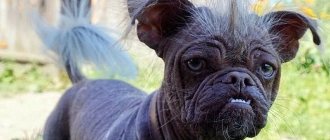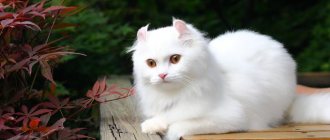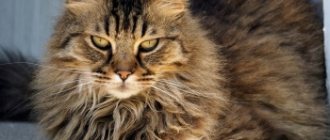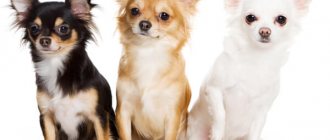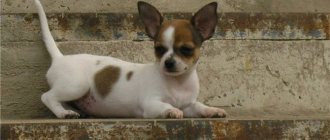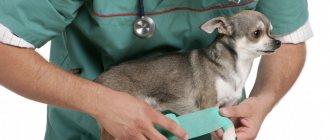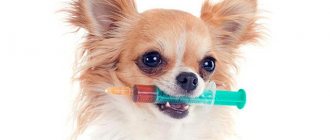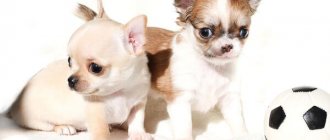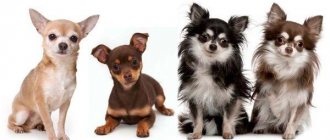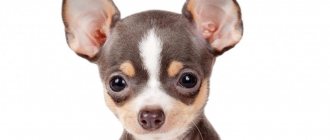The Chihuahua dog is a truly unique dog. Firstly, this breed is recognized as the smallest in the world. Thanks to its balanced character, a Chihuahua can sit quietly in a special bag next to its beloved owner, wherever he goes. Secondly, the Chihuahua is considered one of the longest-livers of the “dog world,” which means that owners will be able to enjoy communication with their pet for a long time.
The average life expectancy of these babies is 14–16 years, but there are cases where dogs lived up to 20.
And of course, the Chihuahua is considered one of the most fashionable dog breeds, because for many decades this breed has enjoyed great success among bohemians and show business stars.
Probably everyone remembers the films “Beverly Hills Belle” - 1, 2 and 3 and “Legally Blonde” - 1 and 2, where small dogs not only accompany their owners, sitting in beautiful bags and on fashionable pillows, but also fight for goodness and justice and show miracles of ingenuity to achieve their goals.
Brief history of origin
Mexico is officially recognized as the homeland of the Chihuahua. They got their name from one of the largest Mexican states - Chihuahua. This breed traces its origins to wild dogs that were domesticated by the Indians who inhabited the territory of Mexico. The Mexicans considered these dogs to be sacred animals and called them “techichi.”
At the beginning of the 16th century, the Spanish conquerors almost completely destroyed the Techichi. For a long time there was no information about them. Only in the middle of the 19th century did information appear about their descendants - local traders near the border with Mexico offered travelers unusually small dogs. This is how representatives of this breed appeared in America and Europe.
They were brought to Russia in 1959 by the leader of Cuba F. Castro, who gave Nikita Khrushchev two such dogs - Mushinka and Mishtera, who later became the ancestor of all domestic individuals of this breed.
This is interesting! In Mexico, the Chihuahua is recognized as the national dog.
Expert opinion
Leonid Rodin
Experienced dog breeder
Ask a Question
Chihuahua fashion has played a ridiculous joke on these miniature dogs. They are often bought for prestige. Faced later with the difficult character of the “Mexican Lilliputian,” the owners are surprised to realize that they have acquired a four-legged personality, and not a resigned living doll. Few people know that at one time in the state of Arizona (USA) there was a serious threat to the safety of children from numerous stray dogs. This fact would not be surprising, but we were talking about packs of homeless Chihuahuas thrown onto the street by their owners. Considering the aggressiveness and natural persistence of this breed, unexpected for such a small stature, the problem could not be resolved by itself. To the surprise of experts, the breeding of dogs was quite active, and the population was rapidly increasing. But at home, Chihuahuas experience difficulties with mating and childbirth. So the state administration had to allocate money to sterilize the rampaging little dogs, create additional places in shelters and remove these four-legged street children from the city outskirts.
Versions of the origin of the breed
There are several popular theories about the origin of the miniature Chihuahua breed. The first theory says that Chihuahuas appeared during the existence of the Aztecs, ancient Indian tribes. In the fifth century BC, the Mayan and Toltec tribes revered and deified the so-called "Techichi", which were tiny dogs. According to some experts, the Chikhov breed was born as a result of crossing a Techichi and a Chinese hairless dog, which was brought to Mexico. In support of this version, scientists found rock paintings in one of the ancient Mexican monasteries. They depicted none other than a Chihuahua. And at the end of the nineteenth century, the remains of unknown tiny dogs were found.
In addition, it is reliably known that dogs always played a significant role in the religious life of the Aztecs. They were perceived not only as a valuable reward for something or one of the attributes of the rich. The priests of Indian tribes always kept special blue dogs, which were needed to protect the sacred blue stone. The tiny four-legged sneezes were untouchable. When the baby's owner died, the dog was buried nearby. This was not done by chance: it was believed that the dog takes upon itself the sins that the owner committed during his life.
The second version claims that the prehistory of the Chihuahua began in Malta. According to history, the entire Maltese territory was inhabited by funny dogs with an open fontanel on their forehead (which is precisely the distinctive feature of purebred representatives). By the way, similar four-legged animals were also discovered in the graves of Egyptians, whose age is impressive - more than three thousand years BC. It is known that there lived a small pocket dog in Malta. And it is possible that this was the ancestor of the current Chihuahua. There are the following arguments in favor of this:
- The pocket Maltese dog and the Chihuahua have almost similar physiological parameters. A small fragile body, long limbs, a thin curled tail and ears sticking out on the top of the head;
- both purebred representatives have an open fontanel (the so-called molera).
The third theory of the origin of Chihuahuas is Mexican. That is, the country where the Chihuahua originated is Mexico, and more specifically, in one of its states – Chihuahua. By the way, the name of the Chihuahua is exactly what the name of this state means. American residents loved to bring home sneezes taken from Mexicans during a tourist excursion.
But the history of Chihuahuas from the sixteenth to the nineteenth centuries is practically unknown. According to rare reports, crumbs were eaten during hungry war times.
Chihuahua dog: interesting facts
Despite the fact that this breed originated several centuries ago, it is becoming more and more popular every year.
Several interesting facts will give you the opportunity to learn more about this breed:
- The American Kennel Club has recognized the Chihuahua as the smallest dog breed in the world. The weight of the largest representative of the breed is 7 kg and height is 23 cm.
- The Chihuahua is one of the top ten dog breeds for life expectancy.
- Compared to body size, the Chihuahua's brain is the largest among dogs.
- The Chihuahua is the most popular dog breed among Hollywood stars.
- Dogs of this breed are fully mature by the first year of life.
History of appearance in Russia
The history of Russian Chihuahuas begins with a pair of dogs, donated by Fidel Castro to N.S. in 1959. Khrushchev during his visit to Cuba. These were long-haired Chihuahuas: Duke and Duchess.
The dogs, which received the pet names Mishter and Mushinka, played a big role in popularizing the Chihuahua in the USSR.
Only Mishter participated in the breeding, while Mushinka left her mark on the history of the breed, like the Chihuahua that first appeared on the screen in our country. The Duchess starred in “The Elusive Avengers” and it is she who can be seen in the arms of Buba Kastorsky.
Later, in the 1960s, a smooth-haired Ryzhik and a long-haired girl named Linda were brought from Algeria.
But only in the 1990s did the mass import of Chihuahuas to Russia begin . Thanks to this, the quality of the domestic dog population has been significantly improved.
The history of the Chihuahua is as mysterious and unusual as the dogs themselves.
Their external features have given rise to many versions of their origin.
Currently, the most reliable hypothesis is considered to be the Mexican one, and the most implausible ones are the alien and Egyptian ones..
It probably isn’t that important anymore where Chihuahuas came from. What is more surprising is that these dogs have long become popular all over the world. And that in Russia alone the number of Chihuahuas exceeds a million individuals.
Breed description, standards and appearance
The first breed standard was published in 1923, and it included only smooth-haired animals. In 1954, long-haired individuals were legalized by dog handlers. The modern breed standard was approved by the FCI in 1998.
It is noteworthy that the standard does not indicate the size of the Chihuahua, so height and weight are not considered indicators of the breed. The main thing is that the weight of the Chihuahua is 0.5–3 kg.
The following growth characteristics are unofficially accepted among breeders:
- if an individual weighs up to 2 kg, then its height should not be higher than 17–23 cm;
- individuals that weigh more than 3 kg must be taller than 25 cm.
The weight of an adult dog is always proportional to its height. “Girls” are usually a little taller and have a slightly more elongated body.
This is interesting! Chihuahuas grow until they are 6–7 months old. At the end of this period, they are just gaining weight, so already at 7 months it is possible to determine the exact growth of an individual in adulthood.
Breeders, trying to improve the breed qualities of individuals, developed the following types of Chihuahuas:
- chihuahua cobby (cobby-type) – have a stocky build, they have a fairly large head and thick hair;
- chihuahua deer (deer-type) - unlike the cobby type, these dogs look like small fawns: they have longer legs, a narrow chest and muzzle.
The ICF standard describes representatives of the Chihuahua breed this way.
- The head is round and shaped like an apple. It is allowed to have a small fontanel that does not close throughout life.
- The Chihuahua's muzzle is short and wide, tapering towards the nose.
- Scissor bite or straight bite.
- The ears are erect, wide at the base and tapering towards the ends.
- The eyes are dark, round, large.
- The nose is usually dark in color or harmonizes with the color of the coat.
- The limbs are long, straight, parallel.
- The paws are small, with splayed toes.
- The tail is of medium length, set high, tapering to a point.
- Based on the type of coat, representatives of the breed are divided into smooth-haired and long-haired.
- Colors can be of a wide variety of shades.
This is interesting! In a purebred individual, the tail is curled into a semi-ring, and its tip is directed towards the lower back.
History of the name of the breed
Most researchers of this breed tend to agree that the home country of the Chihuahua is Mexico, namely the large state of Chiahua, located not far from Texas and the states of New Mexico, but rightfully belonging to Mexico. It was here in the first half of the 19th century. Dog breeders liked dogs of this breed.
Chihuahua: description of dog breed, character
Local residents sold tiny dogs to tourists, who in turn brought them to America. The animals differed in type. They could be smooth-haired or long-haired with a variety of colors. But they all had tiny sizes, a long life expectancy and a calm character, which was especially appreciated by tourists. After all, such animals could live with a child without posing a danger.
For your information! At this time the breed did not have a name. These dogs were called "dogs of Mexico" or "dogs of Chihuahua."
The appearance of a small dog in a Taco Bell advertising campaign ensured its worldwide popularity.
Chihuahua varieties, coat type and color
According to the current FCI standard, there are two varieties of the breed:
- smooth-haired are short-haired dogs with straight, shiny and close-lying hair;
- long-haired - have soft, silky, straight or slightly wavy hair; on their paws, neck, ears and tail their hair is longer than that of short-haired individuals.
You can learn about the characteristics of long-haired dogs here.
The standard provides for the following main types of coat color in dogs of this breed.
- A solid white Chihuahua is rare in nature. White usually serves as a background for other colors. It is noteworthy that long-haired and smooth-haired white individuals are recognized as the standard if they do not have signs of albinism. White smooth-haired Chihuahuas, like their long-haired counterparts, can have hearing problems due to a deafness gene that is passed down from generation to generation.
- The solid black Chihuahua is also uncommon. Black dogs often have a small white patch on their chest or paws.
- Black and white individuals have black or white spots on a corresponding contrasting background (white or black).
- Chocolate-colored Chihuahuas have a brown color with a warm tint, which can be either plain or with markings on the paws and chest.
- The blue Chihuahua has gray fur with a blue or blue tint. Small white markings on a blue background or large gray spots on a white background are acceptable.
- The red Chihuahua, like other solid-colored dogs of this breed, is also rare. The color of such individuals has different variations of shades - from light red to red. Small white markings on the chest and paws are also allowed.
- Purple Chihuahuas are recognized as one of the most beautiful varieties of dogs of this breed. The coat color of such individuals is pink in various shades (from light to dark purple). The lilac color looks very impressive on a Chihuahua with long fluffy hair.
- The brindle Chihuahua has a fawn coat of any shade combined with black or chocolate stripes. Small white markings are also allowed. The brindle coat color is considered one of the rarest and most expressive of the Chihuahua dog breed.
- The fawn Chihuahua has a light yellow coat color. Small white spots and a “mask” on the face are allowed.
- Black and tan individuals have clear tan markings of light tan or reddish color and look similar to miniature pinschers.
It is important! The merle color (or in other words, merle) is prohibited by most cynological organizations, since puppies of this color are often born blind and deaf. In addition, adults may have pathological abnormalities related to the cardiovascular system, bones or eyes.
Description
The history of the Chihuahua breed is very ancient, overgrown with legends and fables. Currently, these small dogs have conquered the whole world, gaining incredible popularity. Their small size makes it easy to take them on trips and trips, and living in city apartments with these pets is very convenient. But the point is not so much in the compactness and unpretentiousness of the content, but in devotion to the owner and affectionate character.
Based on the length of the coat, two exterior variations are distinguished. In the history of the breed, long-haired Chihuahuas are considered more ancient and purebred than representatives with smooth hair. However, more on this a little later.
The first happy owner of small Chihuahuas in Russia was Khrushchev himself, to whom puppies of this breed were brought from Cuba and given as a gift to Fidel Castro. A little later, two more babies were presented to him from Algeria.
All Chihuahua owners note the strong and courageous character of their pets, which does not correlate with their small size. The height at the withers of these dogs reaches only up to 23 cm with a weight of up to 2 kg. It is considered a behavioral feature of the character that the Chihuahua chooses one owner from the family and literally does not leave his person even one step. Experts recommend stopping such manifestations in order to prevent jealous-possessive behavior and aggression.
Chihuahua dog - character and behavior
Despite their miniature size, Chihuahuas are bold and fearless by nature. We can say that this is a dog of one owner, to whom it will be devoted all its life. If the owner devotes time to someone else, this devotion can even turn into jealousy.
Representatives of the breed get along well with those of their relatives whom they have known since childhood. They don't like other people's dogs. Therefore, the owner must carefully monitor the behavior of the pet during a walk. Representatives of the breed are extremely wary of strangers - they always greet arriving guests with a loud bark, and can even bite.
Chihuahuas are smart dogs with a good memory and quickly remember many commands. True, sometimes due to their independent nature, they can be stubborn.
This is interesting! An amazing feature of the breed is the need to bury itself in the folds of a blanket, rug or accidentally forgotten owner’s clothing. This is how they create a refuge for themselves where they can hide from the outside world and be alone with themselves.
Chihuahua and children
Chihuahuas get along well with children and can play with them for a long time. However, you should not allow a child under 8 years of age to play with this dog. Representatives of the breed have very fragile bones, so any blow can cause irreparable harm to the dog’s health.
DNA test sheds light on Chihuahua origins
The Royal Institute of Technology in Stockholm, Sweden, recently conducted a scientific study and compared DNA samples to find out the true origins of the breed. The researchers compared the Chihuahua's mitochondrial DNA to Asian dogs, European dogs and preserved archaeological remains to determine whether they were related.
As a result of the research, scientists came to the conclusion that the Chihuahua does not have any family ties with European and Asian representatives of decorative dogs. However, they discovered a unique type of Chihuahua DNA in Mexican Pre-Columbian samples. Researchers suggest that the Chihuahua dog breed, or its ancestors (such as the Techichi), actually existed in Mexico before the arrival of the Spanish conquistadors.
How to choose the right Chihuahua puppy?
Before buying a puppy, it is advisable to familiarize yourself with the breed standard and avoid the temptation to choose a Chihuahua only based on the color of its eyes and coat. When choosing a puppy, its gender also plays an important role: usually a girl Chihuahua is more capricious, while a boy Chihuahua, on the contrary, will be more obedient and gentle in character.
This is interesting! All Chihuahua puppies, regardless of gender, mark their territory. True, male Chihuahuas do this much more often.
Buy a puppy only from a specialized nursery, where babies are booked at the age of several days. It is better to adopt a Chihuahua puppy at the age of 3-4 months - by this time he will have received all the necessary vaccinations and documents and, possibly, will be toilet trained.
Depending on the size of the Chihuahua, there are several categories: standard (weigh from 2 to 3 kg), mini (1.5–2 kg) and super-mini (up to 1.5 kg). Pedigree standard Chihuahuas cost from 15,000 to 18,000 rubles, mini-individuals are usually a little more expensive - 25,000–45,000 rubles.
Super-mini Chihuahuas are considered the most expensive - 80,000–95,000 rubles. The price is also greatly influenced by the city of purchase: for example, in Moscow and St. Petersburg, puppies will cost several times more than in other Russian cities.
Where to buy and price
It is necessary to buy a puppy from breeders or in club kennels (Strong Style, Apirina Mexicano, De Monsarey). Purebred Chihuahuas must have all fully completed documents. You can buy a cheaper puppy from an ad on the Internet, but you run the risk of buying a sick dog. The price of small pets is quite high and varies depending on the region, color and other indicators from 100 (for a puppy without a pedigree) to 3,500 dollars. This cost is due to the fact that maintaining a pregnant bitch and raising healthy pets requires considerable expenses from the breeder. And keeping this small dog requires a lot of investment, so before you get a dog, you should evaluate your financial capabilities.
Chihuahua puppy in the house - where to start?
Before the arrival of a Chihuahua puppy in the house, you need to thoroughly prepare: purchase bowls, a collar, a leash, toys, a tray and disposable diapers, equip a sleeping place, and also hide small objects, electrical wires and various toxic substances away.
At first, it is advisable to place the puppy in a small room - this way he will quickly get used to the new place. Under no circumstances should you take your baby into your bed, otherwise you will not be able to get rid of your bedmate later.
To toilet train in the first few days, you need to monitor the puppy after sleeping and feeding, and when he starts looking for a secluded corner, take him to the tray. When the baby does his business, you need to praise him. There are several toilet options for representatives of this breed - a tray with a grid or lined with disposable diapers.
An adult Chihuahua boy will definitely appreciate a special toilet with a pole.
Education and training should begin from the very first days of your Chihuahua puppy’s stay at home. The owner must make it clear to the pet that he is a leader, and also show him what can be done and what cannot be done.
Vaccinations
The breeder must give the first vaccination to a Chihuahua on the 28th day after the puppy is born. When purchasing, be sure to check the dog’s passport for a vaccination stamp. Next, the puppy is vaccinated with the complex drug DHPPI + Lepto (against plague, enteritis, adenovirus infection, parainfluenza and leptospirosis) according to the following scheme:
- at 8 weeks - second vaccination;
- at 11 weeks - revaccination;
- after changing teeth - the third vaccination.
Next, the Chihuahua is vaccinated annually with a complex vaccination of DHPPI + Lepto + Rabies. Before each procedure, about a week before, the dog must be dewormed using a special suspension. You should not give anti-worm medications to your pet more than once every six months. This is a poison that affects not only worms, but also their carrier. The active substance of the drug has a detrimental effect on the dog’s liver and kidneys, therefore, together with anthelmintics, it is advisable to give the dog a medicine from the group of hepatoprotectors.
When vaccinating sneezes, an important feature of this breed is taken into account - intolerance of puppies to vaccination against rabies. The first vaccination against this disease is given to babies only at 12 months. After the procedure, they undergo a ten-day quarantine: the animal should not be taken outside and should be protected from hypothermia.
Chihuahua weight and height chart by month
The growth of a Chihuahua depends on heredity, the number of puppies in the litter, as well as the conditions of detention - a well-chosen diet and providing the puppy with sufficient physical activity.
Both puppies and adults, dogs of this breed are prone to overeating. As the puppy grows, you need to control its weight. The table below shows the weight of a puppy of different ages depending on birth weight.
| Age | Puppy weight at birth in grams | |||||||||
| 0 months | 70 | 80 | 90 | 100 | 120 | 125 | 130 | 145 | 160 | 170 |
| 1 month | 210 | 235 | 275 | 325 | 375 | 460 | 490 | 545 | 600 | 655 |
| 2 months | 315 | 375 | 460 | 555 | 615 | 680 | 770 | 830 | 945 | 1055 |
| 3 months | 430 | 545 | 630 | 745 | 855 | 945 | 1055 | 1170 | 1285 | 1400 |
| 4 months | 570 | 715 | 860 | 970 | 1115 | 1255 | 1395 | 1540 | 1680 | 1820 |
| 5 months | 685 | 860 | 990 | 1165 | 1310 | 1485 | 1650 | 1825 | 1995 | 2155 |
| 6 months | 750 | 950 | 1115 | 1265 | 1455 | 1650 | 1850 | 2020 | 2215 | 2415 |
| 18 months | 1000 | 1200 | 1400 | 1700 | 1900 | 2100 | 2300 | 2500 | 2800 | 3000 |
It is important! The difference between the values in the table and the actual weight can be 10-20 grams.
Chihuahua dog - care and feeding
For a puppy, as for an adult Chihuahua, overeating is very harmful, so they need to be fed according to a set schedule:
- newborn Chihuahua puppies in the first three weeks of life feed only on mother's milk;
- When a Chihuahua is 1 month old, you can start introducing complementary foods (kefir, cottage cheese, porridge with meat);
- At 2 months old, a Chihuahua puppy should already be eating its mother’s food. Typically, a 2-month-old Chihuahua eats 6 times a day;
- puppies 3–4 months old eat up to 5 times a day;
- Chihuahuas at 5 months old should eat 4 times a day;
- Chihuahuas from 6 months to a year usually eat 3 times a day;
- From the age of one year, dogs are switched to two meals a day.
It is important! To correctly calculate the volume of portions, the owner needs to know that per 1 kg of dog weight there should be 50–80 grams of food.
For full development, Chihuahua puppies need walks and a balanced diet.
Read about what is best to feed your Chihuahua in the article “Natural or dry food?”.
During the first walks, the baby may experience fear, so it is better to hold him in your arms at first. It is advisable to walk your puppy at least once a day, gradually increasing the duration of the walk from 5 to 30 minutes. In cold weather, your pet should be dressed in special clothing, and in hot weather should not be left in the sun, otherwise he risks getting sunstroke.
To feed his pet, the owner can choose both ready-made food and natural food. In the latter case, it is necessary to additionally give the puppy vitamin supplements.
With a natural diet, the diet of Chihuahua puppies should contain the following products:
- lean meat;
- boiled sea fish without bones;
- cereals;
- greenery;
- eggs;
- vegetables;
- dairy products;
- fruits.
The following are strictly prohibited for representatives of the breed:
- sweets;
- fat meat;
- fried, smoked and salted foods;
- spices and smoked meats;
- legumes;
- bones.
Chihuahua dog - hygiene
Hygienic care for representatives of the breed comes down to washing, caring for the coat, eyes and mouth, cleaning the ears, and trimming the nails.
You need to care for the coat of a Chihuahua as follows: long-haired individuals are brushed with a special massage brush 3-4 times a week, while smooth-haired individuals need to be brushed weekly. It is not recommended to bathe this dog breed frequently, otherwise the coat may become dry and brittle. It is advisable to bathe long-haired individuals approximately once every 2 months, and short-haired individuals - once every 4 months.
For more information about dog hygiene, read the article “How to bathe a Chihuahua correctly.”
Discharge in the corners of the eyes should be removed with a cotton pad soaked in boiled warm water. Plaque that accumulates in the oral cavity is carefully removed with a cotton swab. Ears should be checked weekly for dirt and cleaned with a piece of bandage soaked in a special solution.
Nails should be trimmed weekly with the smallest clippers.
Chihuahua dog – health
The health of a pet depends on the care and body structure, so it is difficult to identify specific diseases that affect representatives of this particular breed. Mainly they have:
- joint dislocations;
- bone fractures;
- various head injuries – newborn Chihuahuas have a fontanel on the head, so any minor head injury can lead to the most dangerous consequences;
- epilepsy;
- hypoglycemia – low blood sugar levels that develop due to too little body weight.
It is important! During the cold season, special dog clothing should not be neglected, since representatives of the breed are prone to ARVI.
Why does a Chihuahua tremble?
Dogs of this breed have an unusual feature - frequent trembling, the main reasons for which are cold, joy, fear, hunger or excitement. If all the causes have been eliminated, but the trembling continues, it is necessary to urgently show your pet to a veterinarian.
Why does a Chihuahua grunt?
Chihuahuas often make sounds similar to grunting. There are several reasons: too narrow nasal passages and excessive excitability of the neuromuscular apparatus of the larynx. This phenomenon is scientifically called “reverse cough” and is not related to diseases.
Who are dogs of this breed suitable for?
Chihuahuas cannot stand being alone. If you leave them alone for more than 4 hours, this will lead to the development of bad habits:
- constant howling;
- grunt;
- barking;
- neglect of the litter box;
- damage to things in the house.
For this reason, representatives of the breed are ideal for lonely people who need a companion and interlocutor.
The need for attention and the ability to listen make Chihuahuas excellent companions for older people
Thanks to good hearing, the Chihuahua is able to report phone calls to hearing-impaired owners. He can bring small objects to his owner, so he will be an excellent helper for an elderly person.
How do Chihuahuas treat children?
Toy dogs are friendly to other family members, but it is not recommended to have them in homes where there are children under 5-8 years of age. The reason is not even the complex nature of the dog, but his fragility and tiny build. A small child who is not yet aware of his actions can inadvertently injure the Chihuahua by stepping on him or accidentally pinching him in a door.
It's not so much that Chihuahuas are dangerous for children, but that children are sometimes dangerous for Chihuahuas.
This pet requires extremely delicate handling, as due to its fragile bones it can easily get a fracture. To injure a dog, simply push him off a high bed.
In addition, Chihuahuas are not known for being particularly affectionate with children. They are suspicious and wary of noisy, restless children, and if they are very frightened, they may even wet themselves.
Chihuahuas are very touchy by nature. If the owner yells at this baby, the dog can sit in one place for several hours until he decides to forgive his offender.
How to make a pet house with your own hands?
A house for a Chihuahua comes in various designs: closed, open or just a bed. In order to make a house with your own hands, you need to take a medium-sized box and cut off the top part.
On all sides, including the inside, you need to cover the box with fabric, and glue an additional sheet of cardboard in the form of a roof. Then you need to cut out the doorway and put a piece of foam rubber covered with fabric “on the floor” of the house. This option for a pet house is very economical and, moreover, will allow the owner to fully express his imagination.
European origin theory
Another assumption is that the Chihuahua originates from Europe, in particular the island of Malta.
Located 80 km below Italy, this Mediterranean island was once home to a small dog known as the Maltese. The similarity of both breeds lies in their size and physical characteristics, and the presence of a soft spot on the skull, called the “molera”. 80-90% of Chihuahua puppies are born with this undeveloped cranial opening.
Another argument linking the Maltese pocket dog with the modern Chihuahua is found in the Sistine Chapel in the Vatican. In 1482, Italian Renaissance artist Sandro Botticelli painted a fresco on the South Wall of a boy holding a small dog that bore a striking resemblance to a modern-day Chihuahua. Botticelli's work is called “The Calling of Moses.”
It can be argued that the Maltese pocket dog is actually a Techichi or Xolo imported from Mexico. However, Botticelli completed the fresco ten years before Christopher Columbus discovered America. Therefore, he could not know what techichi looked like.
Chihuahua dog: pros and cons
It will be useful for the future owner to learn about the main pros and cons of this breed. However, looking at these cute dogs, it immediately becomes clear that they have more advantages than disadvantages.
| pros | Minuses |
| Compact size | Need clothes for walking |
| Devotion | Loud barking |
| Good health and stamina | Only allowed to walk on a leash |
| No need for long walks | Stubbornness and touchiness |
| Have a developed intellect | |
| Their sensitive hearing and clear voice make them excellent watchdogs. |
A dog of this breed will undoubtedly become a friend and a full-fledged member of the family. The little Chihuahua easily adapts to the mood of its owners, and, despite its size, is always ready to help.
